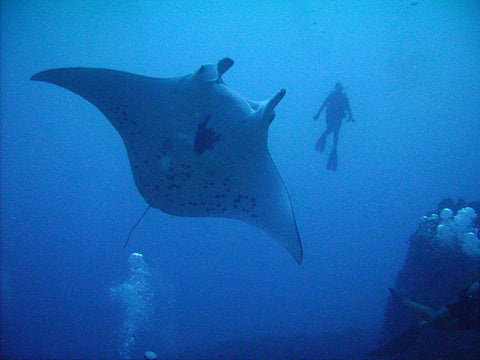FREE SHIPPING ON ORDERS OVER $99 | Hablamos español
Menu
-
-
Shop
-
Courses
-
Dive
-
- Book Now
- Contact Us
- Español
- +1-305-940-0927
- Login
-
United States (USD $)

FREE SHIPPING ON ORDERS OVER $99 | Hablamos español
Shop
Courses

Start Your scuba class today with PADI eLearning!
Book your dive class now!
Manta Ray: Gentle Denizen off the Deep
March 19, 2016 2 min read

In the inky black of a cool and windy night, the divers drop down in pairs, disappearing as the wind and waves rock the boat. Forty minutes later they appear. How was their dive? Blown off a deep wreck, it's a shallower site than expected: The Belcher Barge. Smiling, cold drops glistening like diamonds on his suit, the first diver appears. "That made my season!" the instructor exclaims.
A manta ray, the deep water giant, has swept the site, his 8+ foot wings brushing divers as she majestically flew in the inky dark. Gentle denizens of the deep, this was a small one, as the species' wings can reach 18-23 feet across! Before its gentle nature was observed, it was nicknamed the devil fish as sailors observed it launching itself out of the water.
Usually spotted in more tropical waters, Florida has a couple of sightings each year, as a few species come north to feed on plankton and fish larvae off the coast. Spotting one on a night dive is a special treat! Like other mega fauna, the species is particularly vulnerable to anthropogenic threats. While secondary factors including net entanglements affect the population to some degree, the real threat remains systematic, targeting fishing. Thousands are slaughtered each year (mostly in Sri Lanka, Indonesia, West Africa and South and Central America) solely for their gill rakers. The tough, cartilaginous structure used to strain plankton is lately prized in Chinese Medicine Practice. The demand has lately wiped out entire populations in the Sea of Cortez. In 2011 mantas became strictly protected in international waters.
Whether it is a murky shore dive or an exhilarating drop, the pleasure of diving remain in seeing the unexpected. The thrill of spotting an unusual or endangered species is what keeps us coming back and what can make any dive, even one unplanned, the dive of our season. For more information about mantas and the latest conservation efforts to save the species, please visit www.mantatrust.org
Leave a comment
Comments will be approved before showing up.
Subscribe
Sign up to get the latest on sales, new releases and more …